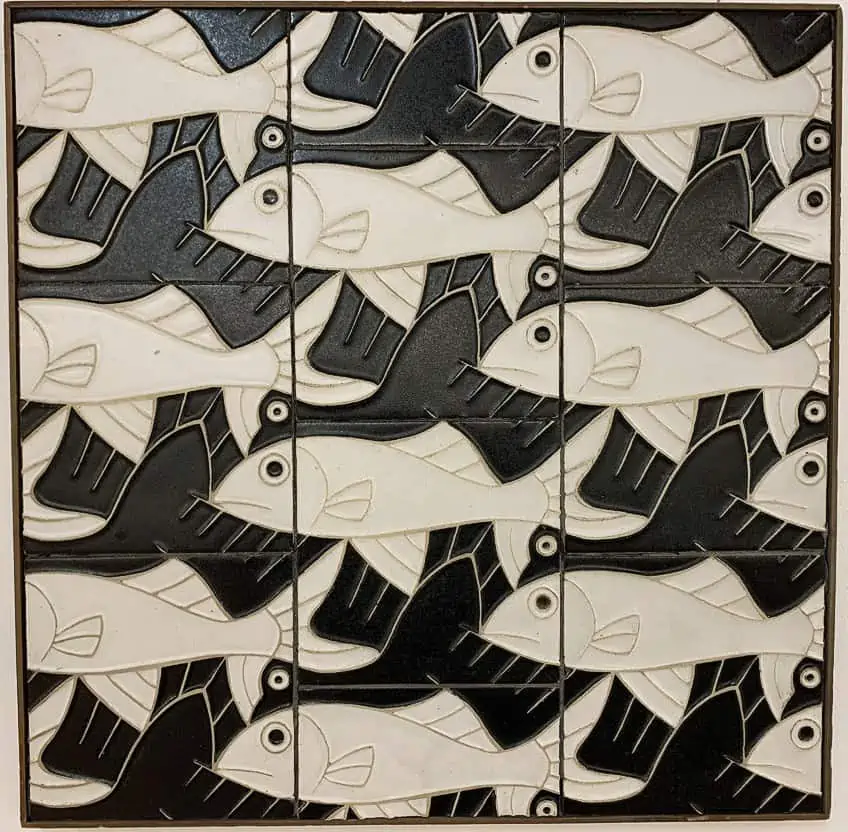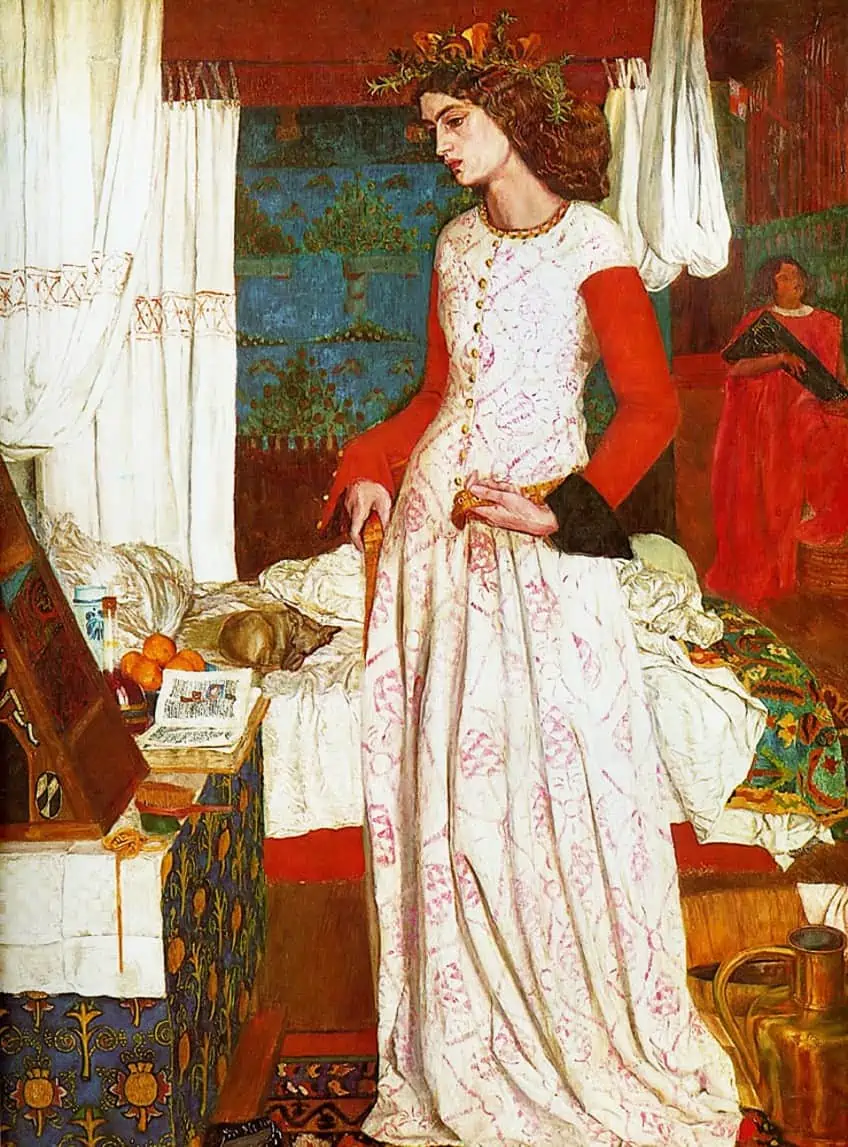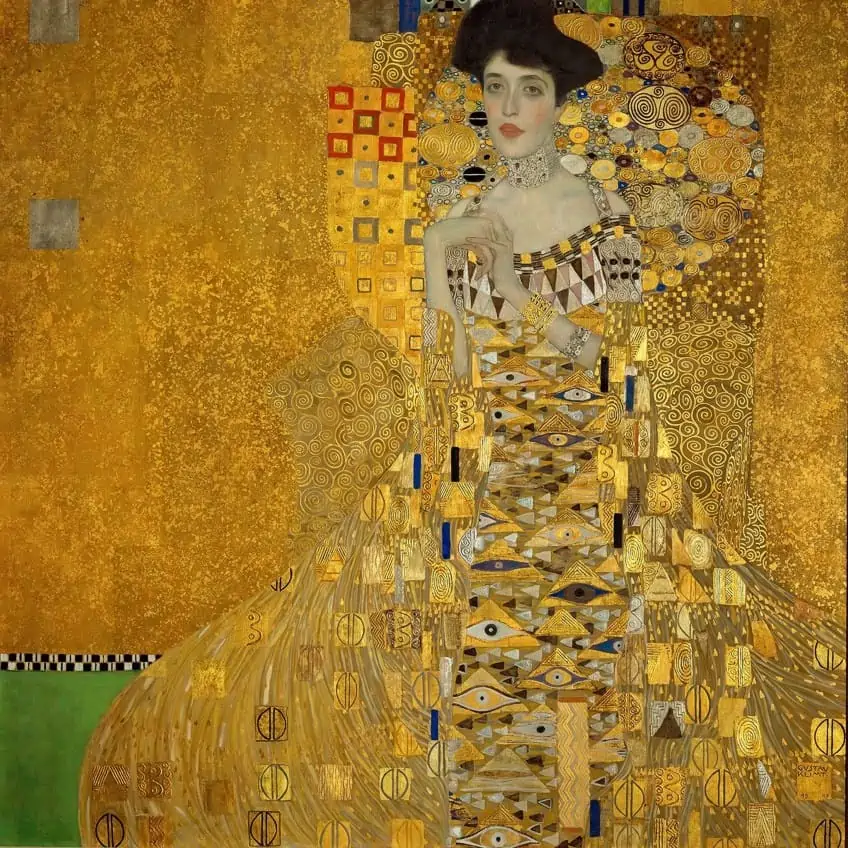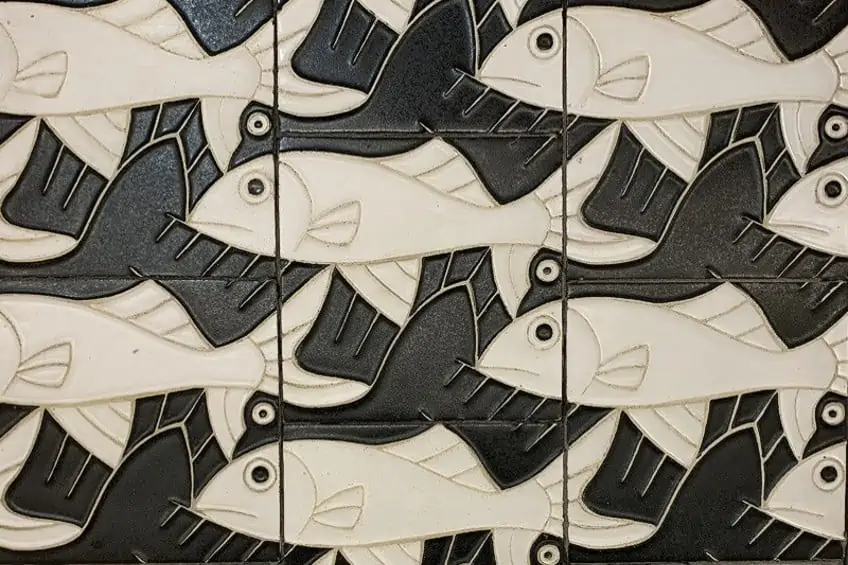Pattern in Art – Discover Different Types of Pattern in Art
What are patterns? What are the different types of patterns in artwork? Why do artists create and use patterns in art? The idea of creating patterns in art has existed for centuries but there is still so much to learn from the world of pattern-making and embedded symbolism that you can use to reframe your way of thinking around producing unique patterns in your practice. In this article, we will explore the dynamic world of patterns through the works of a few famous artists who have employed signature patterns and mark-making methods to establish their unique styles.
Contents
- 1 The Amazing World of Patterns in Art
- 2 The Top 10 Famous Pattern Artists and Artworks
- 2.1 Plans, Elevations, and Details of the Alhambra (1834/1837) by Owen Jones
- 2.2 La Belle Iseult (1858) by William Morris
- 2.3 Portrait of Adele Bloch-Bauer 1 (1903 – 1907) by Gustav Klimt
- 2.4 Day and Night (1938) by M. C. Escher
- 2.5 No. 62. A.A.A. (1962) by Yayoi Kusama
- 2.6 Six Prayers (1965 – 1966) by Anni Albers
- 2.7 Marilyn (1967) by Andy Warhol
- 2.8 Rowan Leaves Laid Around Hole (1987) by Andrew Goldsworthy
- 2.9 Faithless, Kaleidoscope Series (2005) by Damien Hirst
- 2.10 Fermilab 2 (2011) by Sarah Morris
- 3 Frequently Asked Questions
The Amazing World of Patterns in Art
It is useful to unpack a basic understanding of the term “pattern” before we delve into its variations and uses within the art sphere. The term “pattern” broadly refers to a repetitive decorative design. Its function is usually attributed to the field of design where patterns are used as either guides or decorative elements to an artwork or design.
The idea of a pattern lies in its usage, that is, repetition. Repetitive motifs or designs are what we identify as patterns and in art, patterns are used for a variety of purposes.
The main function of a pattern is to highlight a repetitive action and in art, it can be used to relay information about an artwork or serve as a decorative element in an artwork to distinguish one object or texture from another. Some artists employ specific patterns to inform their unique compositions and by using specific selections or arrangements of different patterns, artists can distinguish themselves from the rest of the crowd.

There are many benefits aside from patterns used to give a composition strength. For example, an artist may also choose to use a bold pattern to capture the viewer’s attention or prolong it. Patterns can also be arranged to create illusions and thus help optical illusion artists create spectacular displays. With this in mind, the role of patterns in art expands and can be imagined and created in imaginative ways to produce unique artworks that provide interesting experiences.
Thinking about patterns in art is definitely a strategic move for any artist since the possibilities are endless!
Different Types of Patterns
There is a multitude of patterns to cover but these simple patterns in art will get your mind kickstarted on the right track when it comes to defining basic patterns that can help enhance your artwork. Below, we will explore a few different types of patterns in artwork that will provide you with a holistic understanding of patterns. We will then examine the top 10 most famous pattern artworks and how various artists throughout the 19th and 21st centuries have leveraged art patterns to their advantage.
Natural or Organic Patterns
Natural patterns, as you may guess from the title, occur naturally and are commonly found in nature itself. This can include natural shapes and forms found on seashells, leaves, flowers, snowflakes, and even organic patterns that occur naturally on tree branches. The organic nature of the design of these shapes is what makes them “natural patterns”.
These organic patterns can also be identified through invisible features such as the golden ratio and its use in art over the decades.
Man-Made Patterns
The idea behind man-made patterns stems from the idea of perfectionism and the so-called inherent trait of achieving order via man-made patterns. A classic example of a man-made pattern is the chessboard pattern made up of black and white squares arranged in a way that creates a strong contrast between the blocks on the grid. Notice that it is the arrangement of the square shape such that each corner of each square is aligned in a way that prevents it from overlapping with the squares around it while “meeting” the cornices of each other. It is structured, organized, and “perfect” in design.

Irregular Patterns
Irregular patterns present themselves to us when our minds are faced with interpreting a pattern that does not seem to follow through on its initial “promised perfect state”. This can be understood as witnessing a man-made pattern like a checkerboard dissipate or transform into tiny specks.
Irregular patterns make use of familiar patterns and disrupt them to stir up uncertainty in the viewer and a sense of “abstract newness” or a pattern that behaves irregularly.
The Top 10 Famous Pattern Artists and Artworks
Now that you have gotten a feel for the most common types of patterns in art, let us look at the top 10 most famous pattern artists and artworks that define the role of patterns in art and help us navigate the potential behind the different art patterns.
Plans, Elevations, and Details of the Alhambra (1834/1837) by Owen Jones
| Artist Name | Owen Jones (1809 – 1874) |
| Date | 1834/1837 |
| Medium | Chromolithographs |
| Dimensions (cm) | Unavailable |
| Where It Is Housed | Victoria and Albert Museum, London, England |
Plans, Elevations, and Details of the Alhambra was a book of illustrations created by famous architect Owen Jones and M. Jules Goury between 1834 and 1837. Owen Jones embarked on his tour across Europe, as was the custom for many young upper-class men, in 1832 and made it his own mission to find inspiration for new designs.
His passion for patterns and colors drove him to explore and document patterns from different historical buildings.
The Alhambra in Spain was one such structure that fascinated Jones and the documentation of the patterns from the interior can be seen in his drawings and chromolithographs. Jones was awestruck by the display of color at the Alhambra and began his collaboration with chemists to develop an enhanced way of illustrating the designs through chromolithography.
Unfortunately, Goury died before the works could be published in Plans, Elevation, and Details of the Alhambra.
La Belle Iseult (1858) by William Morris
| Artist Name | William Morris (1834 – 1896) |
| Date | 1858 |
| Medium | Oil on canvas |
| Dimensions (cm) | Support: 71.8 x 50.2, frame: 96 x 75.5 x 6.1 |
| Where It Is Housed | Tate Gallery, London, England |
William Morris is considered to be one of the most famous pattern artists of the 19th century whose patterns and designs are still widely adopted today. Morris was a pioneering figure in the Arts and Crafts movement, which was a collective of artists, craftsmen, designers, architects, and writers who were driven by the societal issues that plagued 19th century industrial Britain.
This movement emphasized the value of hand-made crafts and designs over machine-made products that were quickly promoting mass production and mass consumption.

Pattern designs were a form of protest against the machines of industrialization and for Morris, they were a form of self-expression that pointed to superior design led by man. La Belle Iseult is an 1858 oil painting that reflects Morris’ use of pattern in art and his passion for textiles. This can be seen in the various patterns in the painting, which are rendered with immaculate care and detail.
The painting’s subject was identified as Jane Burden, Morris’ wife, who is dressed in medieval attire. Note that Morris also used rich colors to represent the different patterns and to highlight the details of his true talent in pattern design.
His true talent was not so much figure painting as it was embroidery, pattern design, woodcarving, and illumination. One can immediately identify the checkered pattern on the bottom left of the painting as the white table covering. It is evident that Morris’ attention to textiles and patterns in this painting was the primary object of his affection over the depiction of the figure.
Portrait of Adele Bloch-Bauer 1 (1903 – 1907) by Gustav Klimt
| Artist Name | Gustav Klimt (1862 – 1918) |
| Date | 1903 – 1907 |
| Medium | Oil and gold leaf on panel |
| Dimensions (cm) | 140 x 140 |
| Where It Is Housed | Neue Galerie New York, New York, United States |
Austrian Symbolist Gustav Klimt is one of the best pattern artists of the early 20th century who provides a great framework for thinking around the use of pattern and design in traditional fine art pieces such as Portrait of Adele Bloch-Bauer 1.
The painting was recorded as the most expensive painting in the world in 2006 with the main subject being Adele Bloch-Bauer, who was the wife of a wealthy sugar magnate.

Klimt’s use of pattern in the artwork can be seen in the repetition of checkered and spotty designs on a gold-leaf background. Adele Bloch-Bauer was 26 years old when she modeled for the painting and is the only element of the painting that is not stylized with any design motif, aside from her jewel necklace and lengthy flowing embellished garment.
Klimt combined the use of Byzantine mosaics, Egyptian styles, Mycenaean designs, and Japanese patterns with Art Nouveau and pre-Raphaelite influences of the time to create these exquisite “gold period” artworks.
The subject’s dress reflects Egyptian influences as seen in the eye motifs on her dress and the flattened body form. The many eyes on her dress also allude to the possible relationship that Klimt had with his model. Thus, patterns in art can grant us more clues into the inner world of an artist than the surface-level visual value of the patterns in an artwork.
Day and Night (1938) by M. C. Escher
| Artist Name | Maurits Cornelis Escher (1898 – 1972) |
| Date | 1938 |
| Medium | Woodcut: black and gray |
| Dimensions (cm) | Image: 39.2 x 67.6, sheet: 49.5 x 77.3 |
| Where It Is Housed | National Gallery of Art, Washington D.C, United States |
C. Escher is one of the most famous pattern artists, often referenced for his 1938 woodcut print Day and Night, which accurately portrays the irregular pattern as discussed earlier in the article. The print is currently housed at the National Gallery in Washington D.C and portrays a mirrored landscape with two cities on each end. The most prominent feature is the checkerboard pattern and the birds that gradually emerge at the top to form a tessellation.
A tessellation refers to the use of tile or geometric shapes to cover a plane or surface with no overlaps or gaps. It is often generalized as higher dimensions in mathematics.
Escher was also a mathematician who was so inspired by geometry that he incorporated such principles into his woodcuts, mezzotints, and lithographs. Escher’s work is celebrated globally despite not being as popular in the art sphere during the 20th century.
Escher was also inspired by naturally occurring organisms such as lichen and insects and was most famous among the scientific and mathematical community.
No. 62. A.A.A. (1962) by Yayoi Kusama
| Artist Name | Yayoi Kusama (1929 – Present) |
| Date | 1962 |
| Medium | Paint, mattress stuffing, and cardboard egg crates on canvas |
| Dimensions (cm) | 178 x 202 |
| Where It Is Housed | Blanton Museum of Art, Austin, Texas, United States |
Yayoi Kusama makes use of patterns through the repetition of polka dots, which is her signature style. Kusama is most famous for her installation and performance work that poses questions about human existence in the broader scheme of the universe and the world as a speck in the vast expanse of “dots” in the universe.
Kusama’s artwork can be found in various art museums around the world.
Other works such as Suitcase, Stepladder (1966) also serve as prime examples of pattern in art through the use of natural patterns found on the skin or scales of animals incorporated in the surface of everyday objects. Kusama’s use of mesh and polka dot patterns highlights how one can use a pattern to creatively express abstract or complex ideas through sculpture and installation.
Six Prayers (1965 – 1966) by Anni Albers
| Artist Name | Anni Albers (1899 – 1994) |
| Date | 1965 – 1966 |
| Medium | Cotton, linen, bast, and silver thread |
| Dimensions (cm) | 186.1 x 297.2 |
| Where It Is Housed | The Jewish Museum, New York, United States |
Six Prayers was commissioned textile artwork by the Jewish Museum to serve as a memorial for the victims of the Holocaust tragedy. This challenging task was imagined through the interwoven fabric and pictorial weavings cast on six panels. Anni Albers, a German-born artist, was tasked with the commission and was already well-known for her ability to leverage textiles and patterns to produce elevated, aesthetic works of art.
Albers’ Six Prayers comprises six vertical panels containing beige, white, black, and silver thread.
Albers was born into a Jewish family in Germany and studied weaving before she moved to America. Her husband was a painter and teacher at the Bauhaus School where Albers also studied the Bauhaus style. Other key influences to her work include Paul Klee and textile works of the Andean cultures.
Her scroll-like composition and meditative use of color across the six panels mimic monumental elegy structures and also symbolize the process of Tikkun or social healing or repair.
Marilyn (1967) by Andy Warhol
| Artist Name | Andy Warhol Jr. (1928 – 1987) |
| Date | 1967 |
| Medium | 10 screenprints |
| Edition | 250 |
| Dimensions (cm) | 91.5 x 91.5 |
| Where It Is Housed | Museum of Modern Art, New York, USA |
Marilyn by Andy Warhol is a classic 20th century example of pattern in art as seen through the repetition of color and subject in a uniform arrangement, which is a trademark feature of the work of Andy Warhol. Warhol is one of the most famous Pop art movement artists whose repetitive silkscreen productions such as Marilyn demonstrates the definitive nature of pattern in art and what it could look like.
The repetition of the silkscreen print as a portrait also plays into the metaphor for a loss of self-experience by a celebrity since many of Warhol’s portraits were of popular celebrities.
The repetitive nature of Warhol’s paintings also references industrial practices and a loss of identity through the mass distribution of images and the commodification of celebrities. Consumer culture is very much a prominent subject in many pattern artworks of the 20th century.
Rowan Leaves Laid Around Hole (1987) by Andrew Goldsworthy
| Artist Name | Andrew Goldsworthy (1956 – Present) |
| Date | 1987 |
| Medium | Photography |
| Where It Is Housed | Unavailable |
This photograph was composed and shot by popular British sculptor, Andrew Goldsworthy, who employed nature and photography as his medium through which he could relay the importance of understanding consumption in an environmental context.
The photograph visually presents a spiral pattern composed of leaves that are meant to highlight the natural lifecycle of leaves through their changing colors.
The development and change of color in the natural environment are a pattern that reflects the ongoing cycle of change through birth, endurance, and death, which can be understood in multiple aspects of human life. The natural spiral pattern is also a pattern derived from nature and is often found in cosmically occurring elements such as spiral-shaped galaxies.
Goldsworthy’s eye for framing natural materials and altering our perception of natural cycles is inspiring and uses the familiarity of everyday natural processes to draw attention to the bigger picture.
Faithless, Kaleidoscope Series (2005) by Damien Hirst
| Artist Name | Damien Steven Hirst (1965 – Present) |
| Date | 2006 |
| Medium | Butterflies and household gloss on canvas |
| Dimensions (cm) | 121.9 x 243.8 |
| Where It Is Housed | Private collection |
Faithless is a print by Damien Hirst from his popular Kaleidoscope series executed in 2005. Although Hirst is not recognized as a pattern artist, his use of pattern in this series is an excellent example of how color arrangement via something so simple as butterfly wings can result in such ornate and intricate pattern artworks.
Faithless demonstrates Hirst’s fascination with butterflies through a meticulous arrangement of primary colors.
Hirst worked on the series for around four years and reflects the artist’s interest in death as seen through the lens of science and religion, which are two of the most dominant belief structures for humanity in the contemporary era. The work is also reminiscent of the aesthetic of stained-glass windows and spirituality linked to the symbol of the butterfly and what this arrangement means when arranged in such a clinical, scientific manner.
Butterflies symbolize transformation and transition between life and death.
Fermilab 2 (2011) by Sarah Morris
| Artist Name | Sarah Morris (1967 – Present) |
| Date | 2011 |
| Medium | Household gloss paint on canvas |
| Dimensions (cm) | 122 x 122 |
| Where It Is Housed | White Cube Gallery, New York, United States |
Sarah Morris is one of the most famous Contemporary pattern artists, using architectural patterns derived from the urban environment to highlight the subliminal and hidden psychologies of the spaces around us. Morris is best known for her large-scale geometric patterns and careful placement of color to hint at the culture, politics, and “unsung” narratives of cities. Some of Morris’ most common motifs include electronic music and irregular angles.
Fermilab 2 is a 2011 painting created with household paint in a reminiscent Piet Mondrian-styled grid with additional curved angles on the interior that overlap in color and adds an extra sense of dimension to the painting.
The painting is reminiscent of tinted glass that reflects the luminous lights around it while the overlapping rings allude to the Beijing Summer Olympics of 2008. Subtle decisions in the use of pattern, as seen in Fermilab 2, offer much for an artist to consider when it comes to the use of angles and color in pattern artworks.
The use of patterns in art is incredibly important to relaying your intended message in your artwork. As seen in the many examples of patterns in art above, patterns can be applied in a variety of ways to highlight subliminal messages, societal, and environmental issues. When used strategically, patterns can be powerful tools to enhance your artwork and elevate your concept to the next level.
Take a look at our pattern art webstory here!
Frequently Asked Questions
What Are Patterns?
Patterns are repetitive motifs, symbols, forms, or shapes that are used to decorate or embellish images, objects, and surfaces. Patterns also function as guides and can be used to relay information.
What Are the Different Types of Patterns in Art?
The different types of patterns in art include natural patterns, irregular patterns, and man-made patterns, which are applied in a variety of ways to achieve different visual effects and enhance the composition or visual aesthetic of an image.
Who Is the Most Popular Pattern Artist?
Yayoi Kusama is considered to be the most popular pattern artist in Contemporary art history and is most famous for her use of polka dots in installations across global art museums. Her unique preference for circle shapes developed in the mid-20th century and progressed over time into polka dots, mesh, and lace-like patterns.
Jordan Anthony is a Cape Town-based film photographer, curator, and arts writer. She holds a Bachelor of Art in Fine Arts from the University of the Witwatersrand, Johannesburg, where she explored themes like healing, identity, dreams, and intuitive creation in her Contemporary art practice. Jordan has collaborated with various local art institutions, including the KZNSA Gallery in Durban, the Turbine Art Fair, and the Wits Art Museum. Her photography focuses on abstract color manipulations, portraiture, candid shots, and urban landscapes. She’s intrigued by philosophy, memory, and esotericism, drawing inspiration from Surrealism, Fluxus, and ancient civilizations, as well as childhood influences and found objects. Jordan is working for artfilemagazine since 2022 and writes blog posts about art history and photography.
Learn more about Jordan Anthony and about us.
Cite this Article
Jordan, Anthony, “Pattern in Art – Discover Different Types of Pattern in Art.” artfilemagazine – Your Online Art Source. January 6, 2023. URL: https://artfilemagazine.com/pattern-in-art/
Anthony, J. (2023, 6 January). Pattern in Art – Discover Different Types of Pattern in Art. artfilemagazine – Your Online Art Source. https://artfilemagazine.com/pattern-in-art/
Anthony, Jordan. “Pattern in Art – Discover Different Types of Pattern in Art.” artfilemagazine – Your Online Art Source, January 6, 2023. https://artfilemagazine.com/pattern-in-art/.



